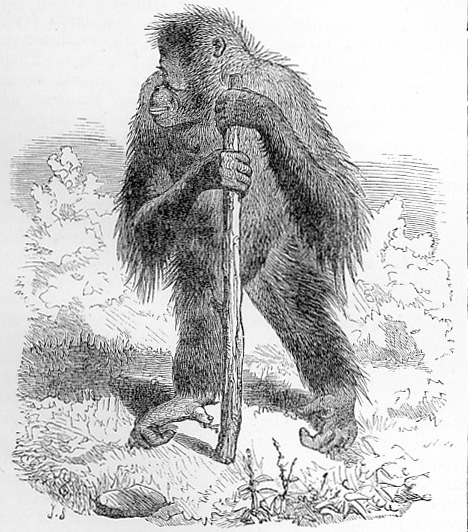1902 Encyclopedia > Ape > Ape: Family I - Simiadae, Sub-Family 1 - Simiinae. The Orang.
Ape
(Part 3)
<
(B) Apes Classified by Family, Sub-Family and Genera
Ape: Family I - Simiadae, Sub-Family 1 - Simiinae. The Orang.
Of the three sub-families into which the Simiadae are divided, the first, SIMINAE, contains only the orang, the chimpanzee, the gorilla, and the gibbons. These are the creatures which, anatomically, are the most like man of all the apes, on which account they are often called the "anthropoid" apes. They are also termed, on account of the relative breadth of their breast-bone or sternum, the "latisternal" or "broad breast-boned" apes.
The orang (S. satyrus) constitutes the genus Simia, which gives its name to the whole family (Simiadae), as well as to the sub-family (Simiinae) to which it belongs. Of this genus there is but one certain species, which is, however, subject to considerable variation.

Fig. 1 -- The Orang-outan [Orang utan] (Simia satyrus). From Mr Wolf's sketch at Zoological Gardens
The orang is exclusively confined to the islands of Borneo and Sumatra, where it frequents the swampy forests near the coast. It attains a height of about 4 feet 4 inches; but its bulk is considerable, its legs, however, being exceedingly short. Its arms, on the contrary, are exceedingly long, reaching down to the ankle when the animal is placed in an erect posture. In harmony with this structure the animal rarely assumes, naturally, a truly erect posture, but walks resting on the knuckles of its hands and the outer sides of its feet, the soles of the latter being turned mainly inwards. Its motions are ordinarily very slow and deliberate, and its demeanour in captivity is languid and melancholy.
It is, in a wild state, exclusively a vegetable feeder, and arboreal in its habits, forming in the trees a sort of nest or shelter of interwoven branches. The animal is covered with long, reddish-brown hair, and there are no naked spaces on the hinder part of the trunk. The forehead is rounded and rather high. Adult males are furnished with a longish beard on the chin, and they may also develop a large warty prominence, consisting of firbo-cellular tissue, on each side of the face. There is no vestige of a tail.
The hands are very long; but the thumb is short, not reaching to the end of the metacarpal bone of the adjacent (index) digit. The feet have exceedingly long toes, except the great toe (hallux), which only reaches to the middle of the proximal phalanx of the index digit of the foot. The hallux is often destitute not only of a nail, but of the second or distal phalanx also; it nevertheless possesses an opponens muscle.
The orang has twelve pairs of ribs, and has, compared with man, an extra wrist bone, or an os intermedium in its carpus.
The brain of the orang has the cerebrum greatly convoluted, and is altogether more like the brain of man than is that of any other ape.
A prolongation is developed from each ventricle of the larynx, and these processes in the adult become enormous, uniting together in front over the windpipe, and forming one great sac which extends down between the muscles to the exilla. There are, however, no cheek pouches. The canine teeth, especially of the adult males, are very large.
Read the rest of this article:
Ape - Table of Contents
|
